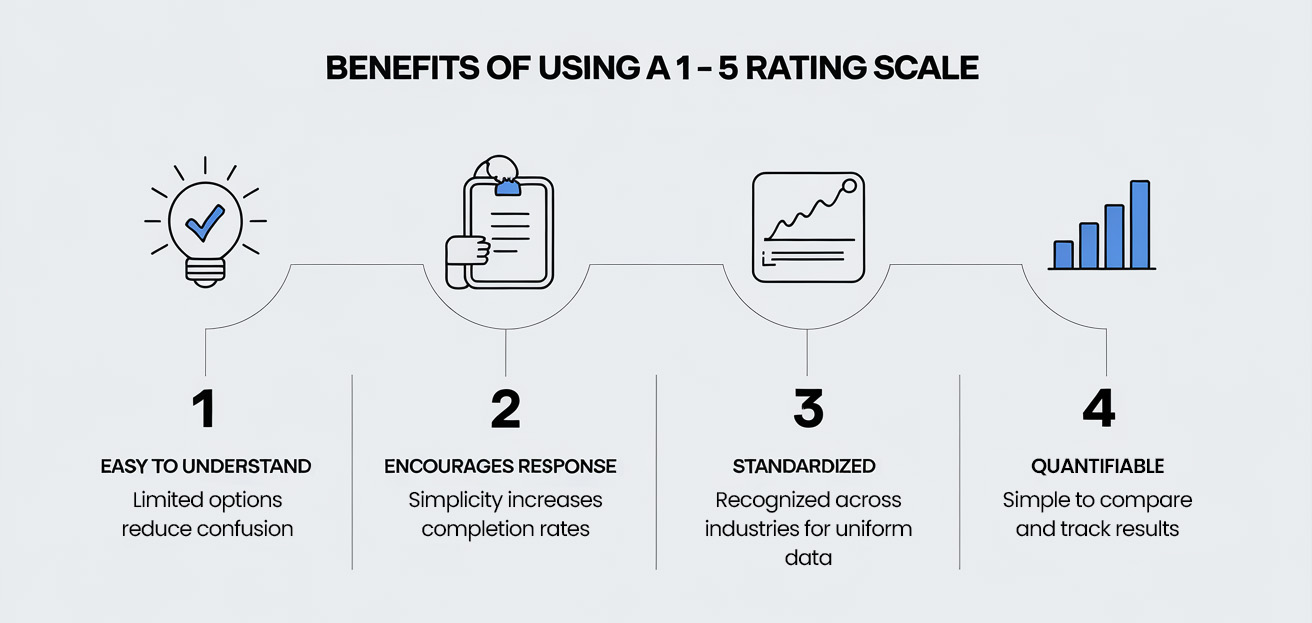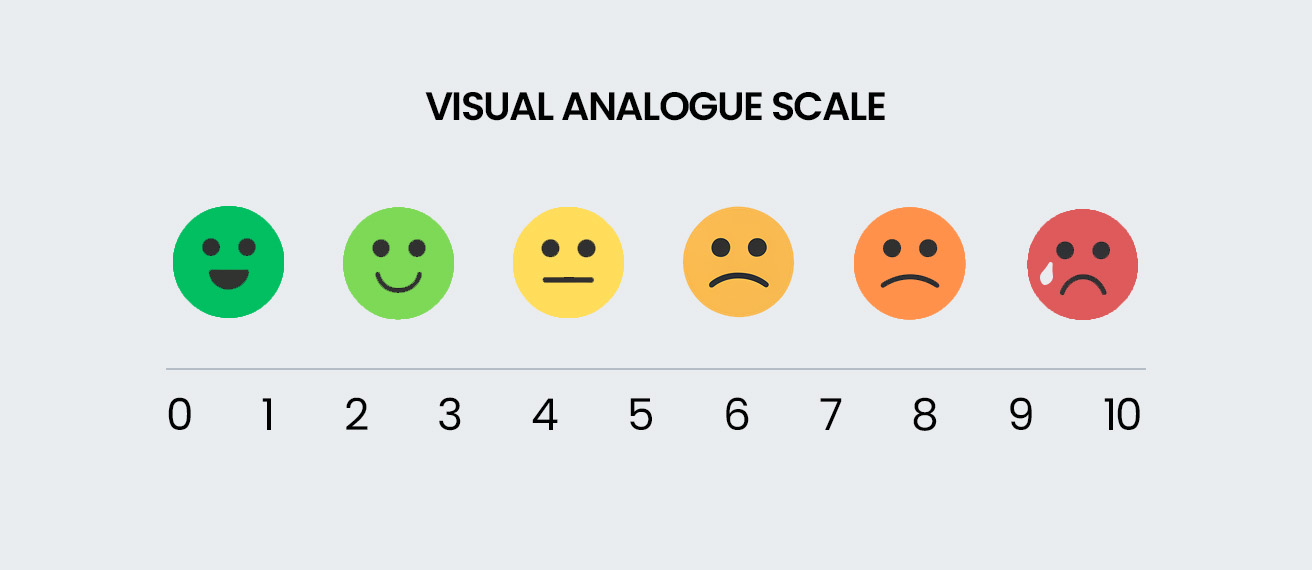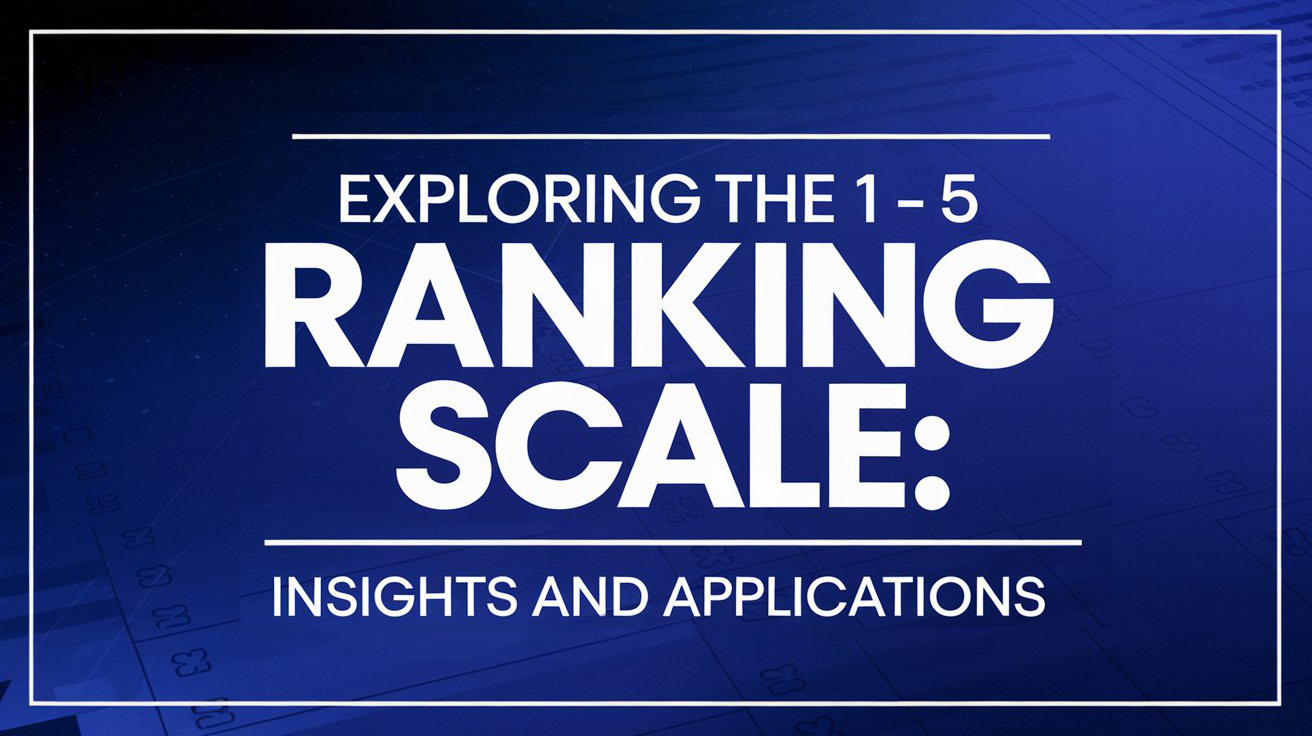The 1–5 ranking scale has become one of the most widely used rating systems across various industries.
Its simplicity and versatility make it ideal for applications ranging from product reviews and customer satisfaction surveys to employee feedback forms.
This straightforward scale provides invaluable data, helping businesses enhance their services and make informed decisions.
Studies show that simplified rating scales, such as the 1–5 Likert scale, effectively increase response rates without sacrificing accuracy. By reducing cognitive load on respondents, these shorter scales lead to more reliable feedback and align with cognitive load theory, which suggests that minimizing mental effort improves response quality and reduces fatigue.
In this article, we will explore why the 1–5 rating scale is so popular, as well as provide tips on how to use it effectively in surveys.
The Power of Simplicity: Why the 1 – 5 Rating Scale Works
When it comes to collecting feedback, keeping it simple is key. The 1 – 5 rating scale offers an intuitive and easy-to-understand framework for both respondents and analysts.
The scale’s midpoint (3) allows for a neutral option, while the extremes (1 and 5) provide clear benchmarks for dissatisfaction and complete satisfaction. This balance encourages users to quickly select their opinions without feeling overwhelmed by too many options.
Moreover, this scale is versatile. Whether you’re conducting market research, measuring customer satisfaction, or even evaluating employee performance, the 1 – 5 rating scale can be adapted to various contexts.
Benefits of Using a 1 – 5 Rating Scale
- Easy to Understand: The limited range ensures clarity and reduces confusion among respondents.
- Encourages Response: Its simplicity increases the likelihood of survey completion.
- Standardized: Widely recognized, making data collection consistent across industries.
- Quantifiable: Results are easy to analyze, compare, and track over time.

How the 1 – 5 Rating Scale is Structured
Each number on the scale represents a different level of opinion or satisfaction. Here’s a common breakdown:
- 1 – Strongly Disagree or Very Dissatisfied
- 2 – Disagree or Dissatisfied
- 3 – Neutral
- 4 – Agree or Satisfied
- 5 – Strongly Agree or Very Satisfied
While this clear breakdown allows participants to express their sentiments easily, alternative scales may sometimes be more suitable depending on the context.
Recent research compares the use of numerical scales, like Visual Analogue Scales (VAS), and pictorial scales (such as emoticons and weights) for measuring cognitive load.

The study found that numerical scales are better for complex tasks, while pictorial scales are more appropriate for simpler tasks, emphasizing the importance of scale design in accurately measuring mental effort and task difficulty.
Survey Examples Using the 1 – 5 Rating Scale
Embedding practical examples can make it easier to visualize the usefulness of this scale in surveys. Below is an example of how the 1 – 5 ranking scale can be applied in different scenarios.
By incorporating these kinds of questions into your survey, you can effectively gauge opinions on key aspects of your business.
Common Applications of the 1 – 5 Rating Scale
This scale is found in a wide variety of settings due to its adaptability. Let’s explore some common use cases:
1. Customer Feedback Forms
Most online businesses, service providers, and even physical stores rely heavily on feedback forms to improve their offerings. A well-designed customer feedback form using the 1 – 5 scale can provide rich data that helps fine-tune services. It’s a powerful way to measure customer satisfaction with various elements of a service, such as:
- Customer support experience
- Quality of the product
- Ease of use of an app or website
2. Employee Surveys
Employee engagement and satisfaction surveys often use the 1 – 5 scale to assess aspects like work-life balance, communication, and leadership effectiveness. These insights help HR departments to address concerns and foster a better work environment.
3. Market Research
In market research, respondents are often asked to rate their preferences for a product, service, or experience. The 1 – 5 scale helps to provide insights into customer preferences and future market trends.
Best Practices for Using the 1 – 5 Rating Scale in Surveys
To maximize the effectiveness of a 1 – 5 rating scale, follow these best practices:
✔️Define Each Point: Ensure each point in the scale is well-defined and that respondents know exactly what each option represents. Avoid vagueness by providing examples where necessary.
✔️Ask Clear Questions: Make sure your questions are straightforward, unambiguous, and avoid leading the respondent.
✔️Combine with Open-Ended Questions: While the 1 – 5 scale is great for quantifiable feedback, supplementing with open-ended questions can provide qualitative insights that explain why respondents chose a particular rating.
✔️Pre-Test Your Survey: Before rolling out your survey, test it with a small group to identify any confusing areas or improvements that need to be made.
Streamline Your Surveys with VeeForm
The right form-building tool can significantly enhance your survey process. VeeForm offers a user-friendly platform that allows you to design custom feedback forms effortlessly.
By incorporating VeeForm into your survey strategy, you can simplify the creation of well-structured feedback forms and maximize the quality of your responses.
You can start using VeeForm for free, with no credit card required, thanks to our free plan.
Pros and Cons of the 1 – 5 Rating Scale
While the 1 – 5 scale is widely used, it is important to weigh the advantages against its limitations.
✔️Pros
- Simplicity: Easy for respondents to understand and complete.
- Uniformity: Data is easily comparable across different groups and timeframes.
- Versatility: Can be used across multiple contexts (e.g., customer feedback, employee engagement, etc.).
❌Cons
- Limited Nuance: With only five options, some respondents may feel their opinion is too constrained.
- Central Tendency Bias: Some users may default to the middle option (3) even if they have a stronger opinion.
That said, for most surveys, the pros outweigh the cons, making it an effective tool for collecting meaningful data.
How to Analyze Results from a 1 – 5 Rating Scale
After collecting responses, interpreting the data becomes the next crucial step.
Here are the best methods for analyzing your results:
- Mean Score Calculation: This is the average of all ratings provided. A higher score typically indicates higher satisfaction or agreement.
- Response Distribution: Understanding the distribution of responses across the scale can help you identify trends or areas of concern. For example, a clustering of responses in the “1” or “2” range may indicate dissatisfaction.
- Textual Analysis: If you’ve incorporated open-ended responses alongside the 1 – 5 scale, perform qualitative analysis to get deeper insights into the “why” behind the scores.
Conclusion
The 1 – 5 ranking scale continues to be a reliable, widely-used tool for collecting feedback. Its simplicity, combined with its versatility, makes it suitable for various types of surveys. Whether you’re gathering customer feedback, evaluating employee engagement, or conducting market research, this scale provides clear and actionable insights.
Tools like VeeForm can take your surveys to the next level by offering powerful form-building capabilities and advanced reporting tools, ensuring you get the most from your data. Start creating impactful surveys with VeeForm today and improve your feedback processes.
However, if you’re looking for even more precision, consider exploring phrase completions—a cutting-edge method that addresses the limitations of Likert scales by providing richer, more detailed data. For more insights on this method, check out our full article on sentence completion surveys as an alternative to Likert scales.
FAQs
What is the advantage of using a 1 – 5 rating scale in surveys?
The 1 – 5 scale is simple, easy to understand, and versatile, making it ideal for collecting feedback quickly and efficiently.
How does the 1 – 5 scale improve response rates?
Its simplicity reduces the mental load on respondents, encouraging them to complete the survey without confusion.
Can the 1 – 5 rating scale be used for qualitative feedback?
While the scale itself is quantitative, it can be paired with open-ended questions to gain deeper insights.
What are the limitations of the 1 – 5 rating scale?
The scale may lack nuance for complex feedback and may encourage central tendency bias, where respondents frequently choose the middle option.
How can I analyze the results from a 1 – 5 rating scale?
Use mean score calculations and response distribution analysis to understand the overall sentiment, along with qualitative analysis of open-ended responses for deeper insights.
